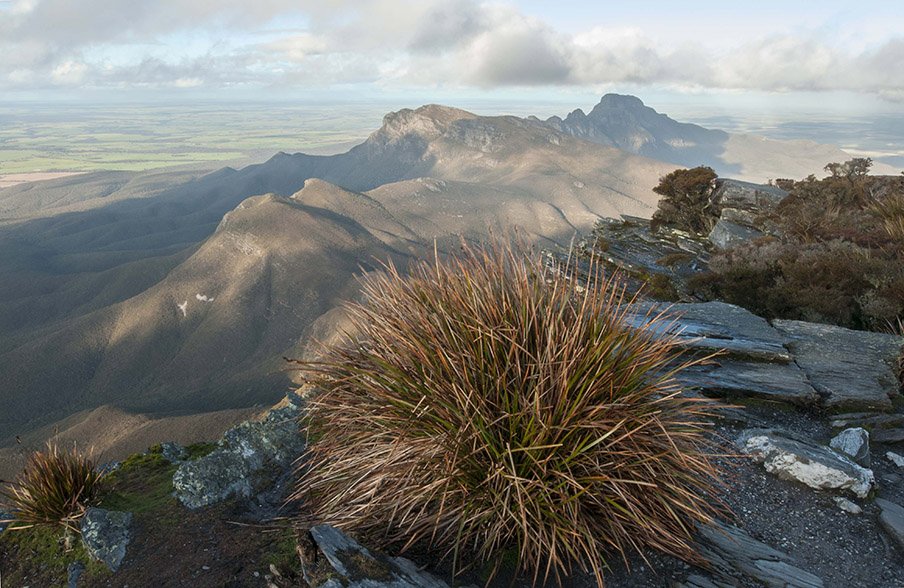Bluff Knoll is the crown jewel of the Stirling Range – the highest peak in southern WA and the only place in the state to get snow with any frequency. It was my first time here and I’d wanted to make the summit by sunset; within the hour, I was reaping the rewards of that plan. The mist was soon awash with golden light, and the sun’s rays through the clouds picked out details in the landscape below to spectacular effect. I could see why Bluff Knoll captures the hearts of many that visit.
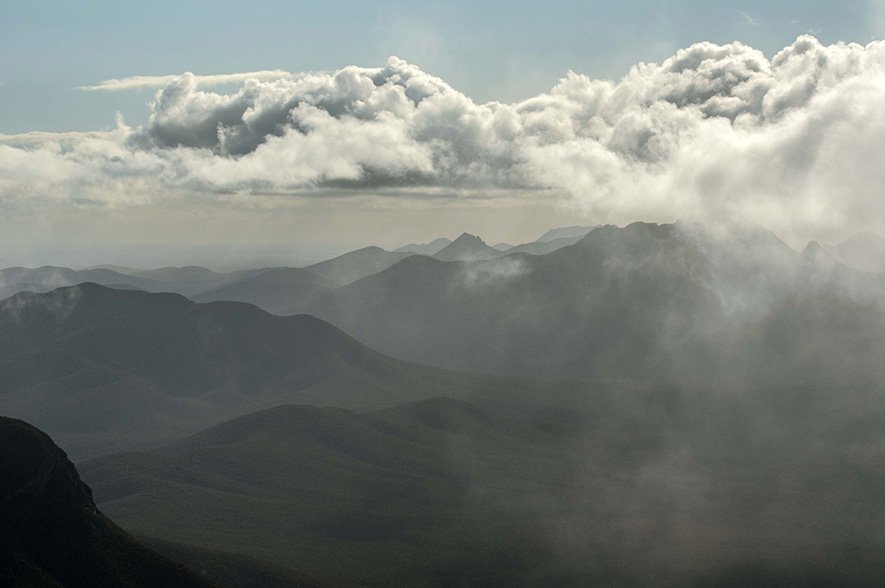
The Stirling Range and its smaller neighbour – the Porongurup Range – were uplifted about 100 million years ago, when the supercontinent of Gondwana broke up and Australia separated from Antarctica. “When two continents are being pulled apart, you develop a valley – a low point – and on the edges you get mountains, which are called ‘rift shoulders’,” says Professor Ian Fitzsimons, a geologist at Curtin University.
Despite a mere 25km separating the parks, the geology of the two ranges couldn’t be more different. The Stirlings are the remnants of an ancient sea, consisting of many layers of sedimentary rock – mostly sandstone and silt-stone – deposited over a long period, beginning 1.8 billion years ago.
“You get these strong differences as you go up the rock’s profile,” Ian says. “In stormy times, you tend to get coarser particles deposited, whereas finer muds will settle to the seabed during quieter times.”
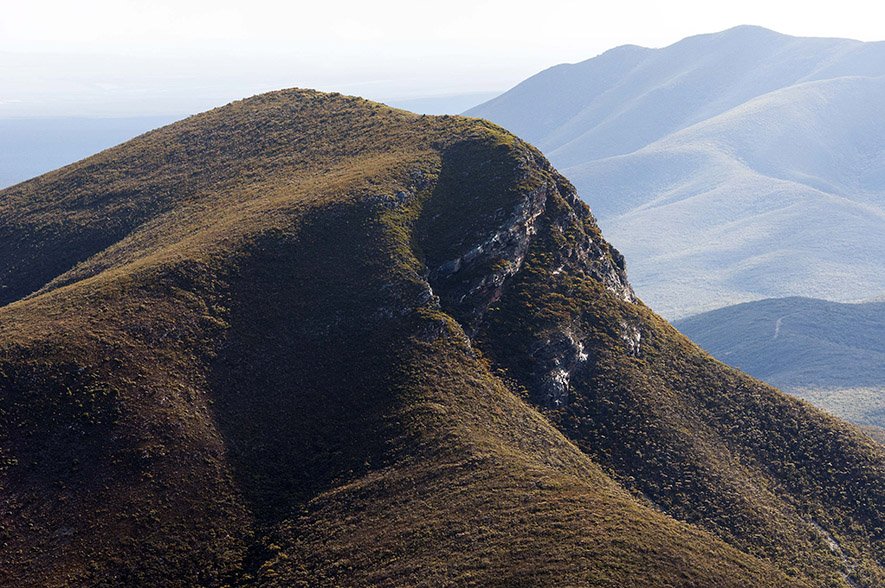
In contrast, the 1.1–1.2-billion-year-old granite boulders of the Porongurups are igneous and metamorphic rocks formed under high temperatures deep inside the Earth. “They are part of a broad belt of granites exposed along the coast, and are more typical of this Great Southern region of WA, with these rocks also found in Albany, Denmark and Esperance,” Ian says. The stone weathers differently, the alternating hard and soft sedimentary layers giving the Stirlings their characteristic jagged edges and steep cliffs, while the tougher granite of the Porongurups has over the aeons smoothed to become the spectacular rounded boulders seen today.
Both ranges fall within the Southwest Australian Ecoregion, one of 35 global biodiversity hotspots. It is home to 7380 plant taxa, about half of which are endemic to an area bounded by Esperance in the south and Shark Bay in the north. The entire region comes alive in spring, with orchids, peas, banksias and feather flowers dotting the landscape in myriad vibrant colours. When I visited in October, I was told that 2016’s cold and wet winter had led to one of the best wildflower seasons in many years.
In the Stirling Range alone, more than 1500 native flowering plant species have been identified, with more than 80 found nowhere else. The different soil types and elevations have resulted in a variety of vegetation communities, from wetlands to woodlands, thicket and mallee-heath. The taller peaks above 750m also house a unique ‘montane’ ecosystem, while nine species of endemic Darwinia, or ‘mountain bells’, are found in various spots above 300m.
The Porongurups are home to more than 700 species of plant, nine of which are endemic, and they also provide habitat for 300 species of macrofungus. The vegetation is visibly different from the Stirling Range’s, dominated by tall jarrah and marri eucalypts, and a majestic karri forest. The mere presence of karris here is surprising. Requiring at least 750mm of rain a year, most of WA’s karri forests (which are genetically distinct from those at the Porongurups) are located south-west of here, about 50km away. It is the ancient granite boulders that allow them to survive here, channelling water to them from the mountain slopes.
The plant life in this region doesn’t completely steal the limelight – there’s also an array of animals including western grey kangaroos, possums, bandicoots, numbats, frogs and reptiles. Twitchers come to spot more than 150 bird species across both ranges, including endangered black-cockatoos and noisy scrub-birds (thought to have been extinct until their rediscovery in 1961).
One sunny morning, I met with Ayleen Sands, who, with her husband, Tony, has run the Stirling Range Retreat for two decades. As we bushwalk on the 50ha property, she points out blooming native peas, orchids and leschenaultias. “This is our 21st spring. We came here for five years, but we fell in love with the mallee country, and with everything that lives and grows in the mallee country,” she tells me. “It’s magic.”
The following day she takes me to her “secret spots” to find orchids. Orchid enthusiasts the world over come to the see the park’s 123 species – and, being one myself, I struggled to contain my excitement as an eager Ayleen pointed out species after species. Within half an hour, I checked off five I had never before seen, including a bucket-list species of mine, the crab-lipped spider orchid.
Ecotourism is a strong focus at the retreat, a testament to Ayleen and Tony’s passion for conservation, and visitors are encouraged to join their daily wildflower and birdwatching tours, “We’ve got to teach people how to not destroy the bush they’ve come to enjoy,” Ayleen adds.
The next day it was on to the Porongurups to meet with members of the Friends of the Porongurup Range. Smaller than Stirling Range, Porongurup National Park seem to be the lesser known, but, with its imposing granite domes and lush forests, it is equally as breathtaking, and clearly beloved of the Friends group, who have devoted much of their time to taking care of it.
At the southern end of Wansbrough Walk I catch up with Bo Janmaat and Klaus and Lisa Braun. The air was cool and damp as we wound our way through thick karri forest in the gully between Nancy Peak and 670m Devil’s Slide, the park’s highest summit.
Continuing up Devil’s Slide, the forest began to thin, and the sandy soil was replaced by smooth granite, splashed bright green with moss. Halfway up the first vast boulder, we stopped to enjoy the incredible scene that had opened up in front of us. A delicate stream trickled down a steep slab of granite, its path framed by orange moss and hundreds of delicate white flowers.
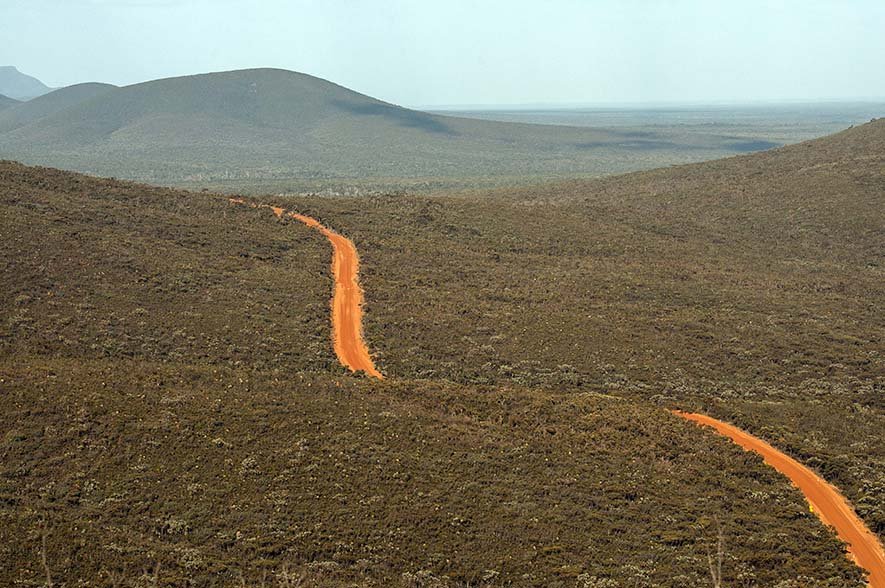
Further below, karri trees filled the gully between the peaks, the many leafless limbs a stark reminder of the 2007 bushfires that had devastated the park, destroying 90 per cent of its 2621ha.
Standing at the first ‘lookout’ – a natural levelling out of one of the domes – we gazed out over green pastures and blue skies. Klaus, who says he has climbed the peak more than 1000 times, turned to me with a grin, saying, “Just horrible, isn’t it?” Once we reached the top I could enjoy the views from 360º. The mist-shrouded Stirlings punctuated the landscape to the north, while fellow Porongurup peaks rose east and west, and pastures extended towards Albany to the south. A deep blue band along the horizon was an unexpected reminder of our proximity to the ocean.
The Porongurups have walks of a range of difficulties, from the gentle Bolganup Trail, winding through karri forest and over a creek on a short loop, to Castle Rock’s class-five ascent, requiring a reasonable level of fitness and an affinity for heights to reach the famous Granite Skywalk.
With six peaks more than 780m high, the Stirling Range offers a number of hikes, ranging from Bluff Knoll’s class-four track – fitted with steps in some areas – to Talyuberlup Peak’s steep ascent and Toolbrunup Peak’s difficult track, complete with rock scrambling. For experienced hikers seeking something extra, the Stirling Range Ridge Walk is a challenging, unmarked, 26km oneway trek through the wilderness zone spanning the area from Ellen Peak at the eastern end of the park across to the Bluff Knoll car park. It takes 2–3 days to complete.
Parks and visitor services officer Mike Shephard says climbers need to be aware of the weather. “You get a lot of swirling winds, you get the clouds in very quickly and it blacks out your view, or whites out your view, so you can’t see where you’re going,” he says. “We’ve had lots of people get lost up here.”
The two parks are also well traversed by rock climbers, with more than 50 routes in the Porongurups. And with names like ‘Two Ants on a Rhino’ and ‘Five Flies on an Elephant’, the sheer scale of the ranges’ boulders becomes clear. Regular climber Jonas Hollingworth says there are nearly 250 routes across the Stirlings, with opportunities for semi-alpine climbing and mountainous weather conditions.
“Bluff Knoll’s north face is about 250-300m high…it’s probably WA’s largest rock face and premiere adventure climbing zone,” Jonas says. “It’s a very historical place for climbing – through the ’50s, ’60s and ’70s, it was the first major climbing area apart from a few spots around Perth.”
The park is also popular among the hang-gliding community, with WA’s gliding clubs hosting wave camps in the Stirling Range each year. It is one of the only places in the state where gliders can use thermals to achieve “diamond height gain”, rising up to an extra 5000m.
Both mountain ranges are deep-seated in the culture of the local Noongar people, but they have different meanings to different groups, depending on their location and the view of the ranges from their traditional lands. To the Goreng of Gnowangerup, north of the range, the Stirlings are a place of great significance, only visited on important occasions.
Robbie Miniter, Gnowangerup’s Noongar community leader, shares the dreamtime tale he was told of their formation during his childhood. “There was a family of three – a warrior, his wife and a child.” The warrior went hunting with his spear, while the mother collected berries with the child. When the father came home empty-handed, an argument erupted, and the man and woman speared each other in the chest.
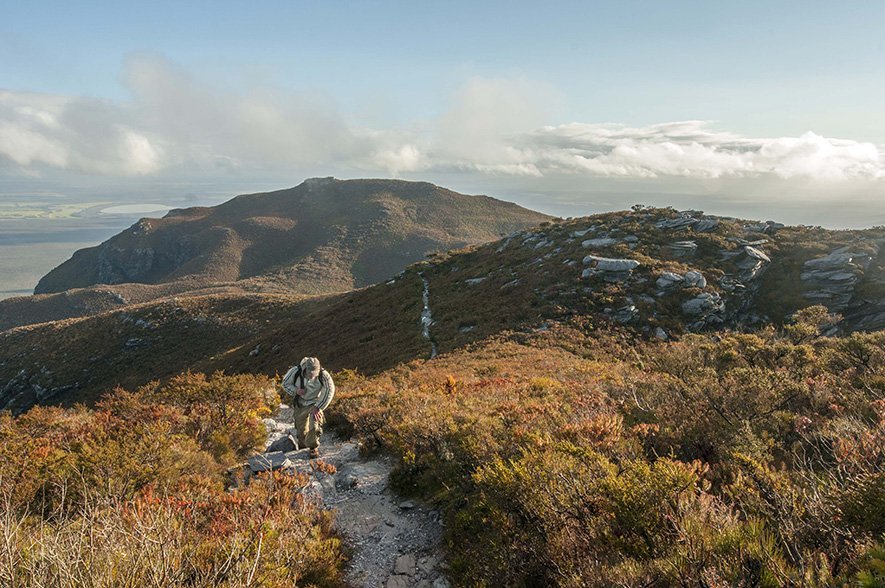
“The mother staggered over and passed away there, which is called the Sleeping Beauty; while the father staggered to where Bluff Knoll is and that’s where he died, and became the King Spirit,” Robbie explains.
Bluff Knoll is also known as ‘Bular Mial, or ‘many eyes’. The Goreng believe it is where their spirits go after death, and the eyes are their ancestors watching over them.
The Porongurups remain a culturally significant spot for the Menang people, on the south of the range. Local Noongar man Harley Coyne says that while little written information has been recorded, “some stories remain about the cultural significance of the range, which include it being a sacred site where ceremonies took place and the starting point or birthplace for Noongar culture”.
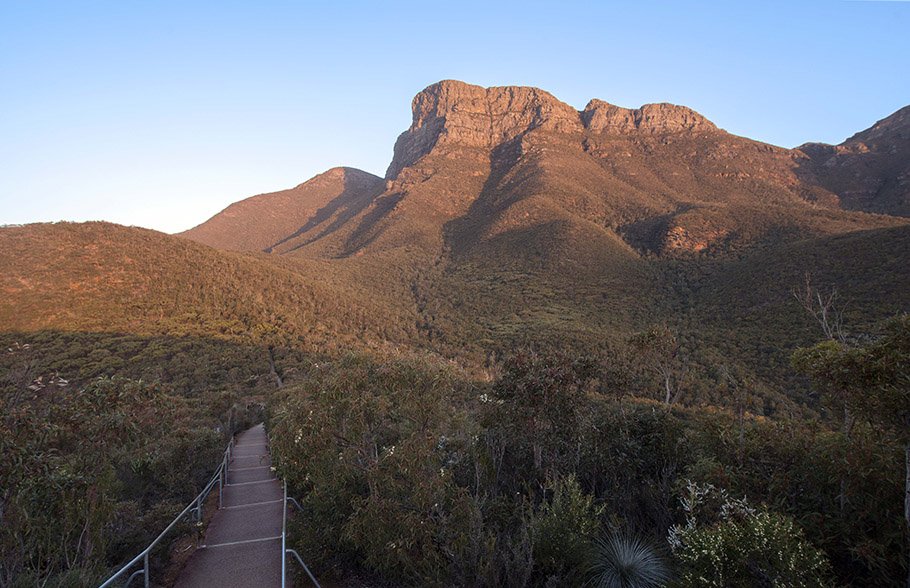
In 1905 European explorer Daisy Bates recorded that the Porongurups were part of a Noongar song cycle that extended 340km north to Perth and beyond. Harley says it is also believed that women went to give birth in the Porongurups, because they’re warm and sheltered. The bushland around the granite domes is still used today, and Harley says he hunts and gathers in the foothills.
The bushland around the Stirlings is also used by the Goreng, who forage for traditional medicine and bush tucker such as quandong and noorjam berries, and hunt animals including kangaroos, bobtails and koonak (yabbies). “We haven’t come this far to let our culture diminish – I go out and I tell these young kids these stories,” says Robbie, who wants to make sure this traditional knowledge is passed on to future generations.
It was the last day of my trip to this Great Southern region – and my final hours of daylight were spent atop Bluff Knoll’s peak. The journey up the mountain had been fascinating, with every twist and turn opening up a new view or revealing a different flower in bloom. As I got higher, the exposure factor increased, bringing new weather conditions.
Finally, as I sat on the summit, the sunset’s golden haze deepened to a misty blue, and there was one thing I could be sure of – this visit to what Stirlings volunteer ranger Eddie Seaman had described as a “little garden of Eden” would most definitely not be my last.
